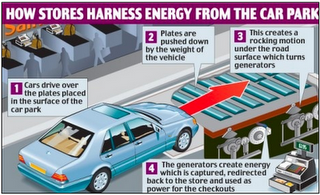Scientists at the university of Texas, Austin have invented nanoparticle inks that can be sprayed on and function as photovoltaic cells. According to Matthew Panthani, a doctoral student working on the project, the team has made "a solution of these nanocrystals...[that can be] sprayed onto a subtrate" such as the sun facing side of a roof. The team developed inks that are made up of copper indium gallium selenide (CIGS), that are 10,000 times thinner than a strand of hair.
The solar cell prototypes they've developed can convert up to 1% of the sunlight that hits the cells into electricity - their end goal is to achieve a 10% conversion rate. Furthermore, the CIGS solution is semi transparent, leading some of the scientists to conclude that the material could even be used in the production of windows so that the windows could double as solar cells.
Doing some preliminary research through the web, I almost literally stumbled upon a few other interesting technologies that are being developed :
New Energy Technologies (Symbol : NENE) announced back in May that they had developed a tinted transparent glass they have named SolarWindow, capable of generating electricity by coating glass with the world's smallest organic solar cells. For those of use geeks out there, New Energy Technologies uses an "organic solar array, which achieves transparency through the creative use of conducting polymers" (link to study here). The biggest breakthrough in this technology is its ability to generate electricity not only from the visible light spectrum (sun produced light), but also through artificial light.

Formula 1 cars have been able to translate the kinetic energy produced when braking into additional energy for some time now. What is new, however, is the application of this technology to roads. In Gloucester, U.K., a Sainsbury store has installed kinetic plates which get pushed down every time a vehicle passes over them, which then moves hydraulic pipes that drive a generated. These plates can generate up to 30kw of energy an hour, which is more than enough to power Sainsbury's checkout registers.
The most interesting aspect of the two latter technologies is their ability to "recycle" energy that's already been expended. I believe the key to technological breakthroughs in the energy space lie in making the use of our energy more efficient while simultaneously being able to recycle the energy that is used. Imagine your laptop charged its battery the more you typed, by absorbing the kinetic energy released when you type. What if the interior of our homes were lined with nanoparticles that enabled them to absorb all of the artificial light emitted once the sun sets? What if the national highways in the United States were able to absorb the kinetic energy released by the millions of cars, trucks and buses going over them every day?
Related / Source Articles :
http://isiria.wordpress.com/2009/05/21/windows-that-can-generate-electric-energy-from-sunlight-and-artificial-lighting/
http://jrse.aip.org/jrsebh/v1/i1/p013101_s1
http://www.livescience.com/technology/090824-spray-on-solar-cells.html

![Reblog this post [with Zemanta]](http://img.zemanta.com/reblog_e.png?x-id=937a0b37-2e41-45eb-974f-f380cdeb9669)